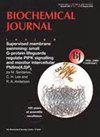Structure, kinetics, and mechanism of Pseudomonas putida sulfoquinovose dehydrogenase, the first enzyme in the sulfoglycolytic Entner-Doudoroff pathway.
IF 4.3
3区 生物学
Q2 BIOCHEMISTRY & MOLECULAR BIOLOGY
引用次数: 0
Abstract
The sulfosugar sulfoquinovose (SQ) is catabolized through the sulfoglycolytic Entner-Doudoroff pathway, beginning with the oxidation of SQ to sulfogluconolactone by SQ dehydrogenase. We present a comprehensive structural and kinetic characterization of Pseudomonas putida SQ dehydrogenase (PpSQDH). PpSQDH is a tetrameric enzyme belonging to the short-chain dehydrogenase/reductase (SDR) superfamily with a strong preference for NAD+ over NADP+. Kinetic analysis revealed a rapid equilibrium ordered mechanism in which the NAD+ cofactor is the first substrate to bind, and NADH is the last product to dissociate. Structural studies revealed a homotetrameric structure in solution and crystals, involving cross-subunit interactions in which the C-terminus residue (Gln260) inserts into the diagonally opposite subunit to form part of the second shell of residues lining the active site. Complexes of PpSQDH with SQ or NAD+ provide insight into the recognition of SQ and together with the kinetic analysis allow the proposal of a catalytic reaction mechanism. Our findings illuminate the mechanism of SQ degradation and the evolution of the SDR superfamily for organosulfonate catabolism.恶臭假单胞菌硫酸喹诺糖脱氢酶的结构、动力学和机制,这是硫解enner - doudoroff途径中的第一酶。
巯基喹诺糖(SQ)是通过巯基喹诺糖水解的enterner - doudoroff途径进行分解代谢的,首先通过SQ脱氢酶将SQ氧化为磺基喹诺糖内酯。我们介绍了恶臭假单胞菌SQ脱氢酶(PpSQDH)的结构和动力学表征。PpSQDH是一种四聚体酶,属于短链脱氢酶/还原酶(SDR)超家族,与NADP+相比,它更倾向于NAD+。动力学分析揭示了一个快速平衡有序机制,其中NAD+辅因子是第一个结合的底物,NADH是最后一个解离的产物。结构研究揭示了溶液和晶体中的同四聚体结构,涉及跨亚基相互作用,其中c端残基(Gln260)插入对角线相反的亚基,形成活性位点的残基第二壳的一部分。PpSQDH与SQ或NAD+的配合物提供了对SQ识别的深入了解,并结合动力学分析提出了催化反应机制。我们的研究结果阐明了SQ降解的机制和SDR超家族在有机磺酸盐分解代谢中的进化。
本文章由计算机程序翻译,如有差异,请以英文原文为准。
求助全文
约1分钟内获得全文
求助全文
来源期刊

Biochemical Journal
生物-生化与分子生物学
CiteScore
8.00
自引率
0.00%
发文量
255
审稿时长
1 months
期刊介绍:
Exploring the molecular mechanisms that underpin key biological processes, the Biochemical Journal is a leading bioscience journal publishing high-impact scientific research papers and reviews on the latest advances and new mechanistic concepts in the fields of biochemistry, cellular biosciences and molecular biology.
The Journal and its Editorial Board are committed to publishing work that provides a significant advance to current understanding or mechanistic insights; studies that go beyond observational work using in vitro and/or in vivo approaches are welcomed.
Painless publishing:
All papers undergo a rigorous peer review process; however, the Editorial Board is committed to ensuring that, if revisions are recommended, extra experiments not necessary to the paper will not be asked for.
Areas covered in the journal include:
Cell biology
Chemical biology
Energy processes
Gene expression and regulation
Mechanisms of disease
Metabolism
Molecular structure and function
Plant biology
Signalling
 求助内容:
求助内容: 应助结果提醒方式:
应助结果提醒方式:


